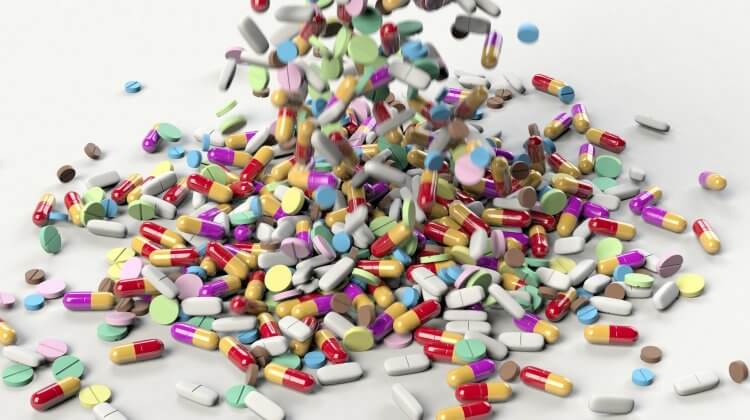
Selective androgen receptor modulators, or SARMs for short, sound mythical. The ideal SARM has all the positive effects of anabolic steroids, while not having any of the downsides or side effects. In general, the positive effects are considered to be its muscle-building effect and its stimulatory effect on bone mineral density. All the other effects are usually considered unwanted. Although, of course, that largely depends on the degree to which they occur (and who you’re asking). For example, anabolic steroids induce erythropoiesis — the process of red blood cell production. This leads to an increase in hematocrit, which, when it gets too high, increases the risk of venous thrombosis. However, if you would completely get rid of any stimulatory effect on erythropoiesis, hematocrit might get too low. As a result, you end up being anemic. So even some of those unwanted effects of AAS are ‘wanted’ to some degree. For the sake of simplicity, however, I will ignore this for the remainder of the article and pretend we want SARMs to only do something in skeletal muscle tissue.
SARMs rely on tissue selectivity
Obtaining those muscle-building effects without side effects, how is that possible? How are SARMs gonna achieve that? In essence it boils down to tissue selectivity. Meaning that it does its job in muscle tissue, but not in others. One way of achieving this is by some molecular fapping involving activation of the androgen receptor (AR) specifically in muscle tissue. While the AR is the same in all tissues, the cellular context is different: you can imagine that the contents of a muscle cell are quite different from that of a sebaceous gland cell. When the AR gets activated to induce gene transcription — which will ultimately lead to muscle gains — a lot of other proteins come into play. These proteins that are involved in transcription are so-called transcriptional coregulators. Let’s call them cofactors for short. These can either aid in transcription (coactivators) or repress it (corepressors). Which cofactors, and the proportions of them, that get recruited by an activated AR, can vary from one tissue to another. This is, in part, dependent on which molecule is bound to the AR. As such, a SARM might be able to recruit a bunch of cofactors that will lead to little or no gene transcription in tissue A, while leading to full gene transcription in tissue B (muscle).
The above sounds pretty complex, and it is. After all, how would you know which kind of ligand for the AR interacts with which cofactors and to what degree? You don’t, you’ll need to run your compound to endless tests to actually determine this. And this process happens to be very time-consuming. Nevertheless, this is currently being touted as one of the reasons why SARMs — in essence having discovered this by ‘accident’ — exert their tissue-specific effects. For example, the steroidal antiandrogen TSAA-291 has been shown to exert tissue-specific activity which coincided with differential coregulator recruitment profiles compared with dihydrotestosterone (DHT) [1]. However, because they didn’t compare other AAS, it might as well be that they’d see different coregulator recruitment profiles with other AAS. As such, it’s hard to see how relevant it actually is for SARM-specific properties. After all, correlation doesn’t imply causation.
Another way a SARM could exert tissue specificity is through the way it might be metabolized. A molecule gets metabolized by the action of enzymes. And the presence of such metabolizing enzymes can differ from one tissue to another. For example, this is very evident with the metabolization of testosterone. Testosterone is susceptible to metabolization by reduction on its 5th carbon atom. This reduction is catalyzed by the enzyme 5α-reductase. The result of this reduction is the more potent androgen dihydrotestosterone (DHT). As such, testosterone’s effect gets amplified in tissues expressing this enzyme. Unfortunately, skeletal muscle is not one of those tissues. And, quite in fact, DHT is broken down to the very weak androgen 3α-androstanediol by the enzyme 3α-HSD in muscle [2], thus decreasing its effect there.
However, this aspect is a bit different for SARMs. Steroidogenic enzymes, such as 5α-reductase and 3α-HSD, have no effect on nonsteroidal SARMs. The enzymes which do metabolize SARMs vary from one class of SARMs to the other. As such, it needs to be researched for each and every SARM how it gets metabolized, and at which rate this occurs in the various tissues. This is more trivial for most AAS in which you can largely predict it. This makes it a difficult angle for SARM-development to focus on.
Finally, it’s known that AAS can also exert nongenomic effects [3]. As the name kind of gives away, these are effects that aren’t mediated by gene transcription. As such, these effects occur very rapidly (within seconds/minutes after exposure of a cell to it). Some research indicates that the classical androgen receptor localized in the plasma membrane, as well as other membrane-bound receptors, mediate these effects. Hypothetically it’s possible that AAS — and by extension SARMs — are able to affect signaling pathways depending on the cellular context, i.e., the effects might differ from one cell to another: tissue specificity.
20+ years of SARMs research: 0 approved
Knowing these things is nice, but it’s a far stretch from being helpful (yet) in the development of SARMs. But at least it provides a basis through which SARMs could actually work. Yet, after over 2 decades of SARM research [4], not a single one has been approved by the Food and Drug Administration (FDA).
Part of the reason why this is, can be traced back to how researchers have been screening for potential SARMs. As I’ve narrated out in a previous article, the anabolic to androgenic ratio as assessed by the Hershberger assay, is completely useless. Yet this assay has been used by pharmaceutical companies to decide whether or not to further pursue certain SARMs of interest, this includes GTx, Inc. with the development of enobosarm (GTx-024) [5], GlaxoSmithKline with the development of GSK2881078 [6], Takeda Pharmaceutical Company with the development of SARM-2f [7], Aska Pharmaceuticals with the development of S42 [8], Merck & Co, Inc with the development of MK-4541 [9], etc.
Haven’t we already seen ridiculously good results with conventional AAS in the past using these assays? Yes we have. For example, stanozolol is touted to have an anabolic to androgenic ratio roughly 10 times higher than that of testosterone and methyldrostanolone roughly 20 times higher [10]. Yet, as we know, these products aren’t considered pretty near-ideal SARMs. Because this isn’t how it works, as narrated out in my previous article.
A further problem with SARM research comes to light when looking at the clinical trials. Since SARMs are being developed to outperform conventional AAS, wouldn’t you expect them to be compared to conventional AAS in clinical trials? For some reason, in all clinical trials with SARMs, they are compared to a placebo. If you want to assess efficacy, don’t do this compared to a placebo — or perhaps only initially in a pilot trial to save costs, just see if it’s junk or not. These trials commonly show marginal gains (in the 1 kg range) of LBM over a period of several weeks/months time with corresponding good tolerability. Whoopty doo. Conventional AAS are also usually tolerated well and marginally increase LBM when dosed low, nothing shocking there. Ligand Pharmaceuticals even found the need to mention the following in the conclusion of their study abstract covering the effects of their SARM LGD-4033: “LGD-4033 was safe, had favorable pharmacokinetic profile, and increased lean body mass even during this short period without change in prostate-specific antigen.” What did they expect in a few weeks time with their SARM? Even 600 mg of testosterone weekly for 20 weeks doesn’t increase prostate-specific antigen (PSA) in young men [11, 12] or in older men [13].
If the only requirement is that it’s more efficacious than a placebo while being well-tolerated, they’ve nailed it. But pretty much all conventional AAS are more efficacious than a placebo too while being well-tolerated. Outperforming placebo was never the goal with SARM development, so why are head-to-head trials still severely lacking?
Conclusion
SARMs rely on tissue selectivity in order to exert potent anabolic (muscle-building) effects, while keeping side effects to an absolute minimum. After all, side effects largely boil down to androgenic action in tissues other than muscle. SARMs can exert these tissue-specific effects through roughly three different mechanisms. One exploits the differences in molecules between different cell types that ‘help’ a SARM to initiate gene transcription. Another relies on tissue-specific expression enzymes that metabolize SARMs. A third relies on the nongenomic effects that might be mediated by a SARM, which, again, might vary from one cell type to another.
Since this stuff is extremely difficult to predict up-front, pharmaceutical companies need to screen a lot of molecules to see which one might be the best fit. No SARM has been approved yet, and I believe this is in part due to this screening process which relies on outdated, flawed, methods like the Hershberger assay. This needs to be improved.
So what road should SARM research head in? I’m gonna leave you in suspense, as that’s food for a future article.
References
1. Hikichi, Yukiko, et al. “Selective androgen receptor modulator activity of a steroidal antiandrogen TSAA-291 and its cofactor recruitment profile.” European journal of pharmacology 765 (2015): 322-331.
2. Becker, H., et al. “In vivo uptake and metabolism of 3H-testosterone and 3H-5α-dihydrotestosterone by human benign prostatic hypertrophy.” European Journal of Endocrinology 71.3 (1972): 589-599.
3. Foradori, C. D., M. J. Weiser, and R. J. Handa. “Non-genomic actions of androgens.” Frontiers in neuroendocrinology 29.2 (2008): 169-181.
4. Negro-Vilar, Andres. “Selective androgen receptor modulators (SARMs): a novel approach to androgen therapy for the new millennium.” The Journal of Clinical Endocrinology & Metabolism 84.10 (1999): 3459-3462.
5. Kim, Juhyun, et al. “The para substituent of S-3-(phenoxy)-2-hydroxy-2-methyl-N-(4-nitro-3-trifluoromethyl-phenyl)-propionamides is a major structural determinant of in vivo disposition and activity of selective androgen receptor modulators.” Journal of Pharmacology and Experimental Therapeutics 315.1 (2005): 230-239.
6. Neil, David, et al. “GSK2881078, a SARM, produces dose-dependent increases in lean mass in healthy older men and women.” The Journal of Clinical Endocrinology & Metabolism 103.9 (2018): 3215-3224.
7. Aikawa, Katsuji, et al. “Synthesis and biological evaluation of novel selective androgen receptor modulators (SARMs) Part III: Discovery of 4-(5-oxopyrrolidine-1-yl) benzonitrile derivative 2f as a clinical candidate.” Bioorganic & medicinal chemistry 25.13 (2017): 3330-3349.
8. Min, Liu, et al. “A novel synthetic androgen receptor ligand, S42, works as a selective androgen receptor modulator and possesses metabolic effects with little impact on the prostate.” Endocrinology 150.12 (2009): 5606-5616.
9. Schmidt, Azriel, et al. “Identification of an anabolic selective androgen receptor modulator that actively induces death of androgen-independent prostate cancer cells.” The Journal of steroid biochemistry and molecular biology 143 (2014): 29-39.
10. Basaria, Shehzad, et al. “The safety, pharmacokinetics, and effects of LGD-4033, a novel nonsteroidal oral, selective androgen receptor modulator, in healthy young men.” Journals of Gerontology Series A: Biomedical Sciences and Medical Sciences 68.1 (2013): 87-95.
11. Bhasin, Shalender, et al. “Testosterone dose-response relationships in healthy young men.” American Journal of Physiology-Endocrinology And Metabolism (2001).
12. Bhasin, Shalender, et al. “Effect of testosterone supplementation with and without a dual 5α-reductase inhibitor on fat-free mass in men with suppressed testosterone production: a randomized controlled trial.” Jama 307.9 (2012): 931-939.
13. Bhasin, Shalender, et al. “Older men are as responsive as young men to the anabolic effects of graded doses of testosterone on the skeletal muscle.” The Journal of Clinical Endocrinology & Metabolism 90.2 (2005): 678-688.
About the author
Peter Bond is a scientific author with publications on anabolic steroids, the regulation of an important molecular pathway of muscle growth (mTORC1), and the dietary supplement phosphatidic acid. He is the author of several books in Dutch and English, including Book on Steroids and Bond's Dietary Supplements.

1 reply
Loading new replies...
Join the full discussion at the MESO-Rx →